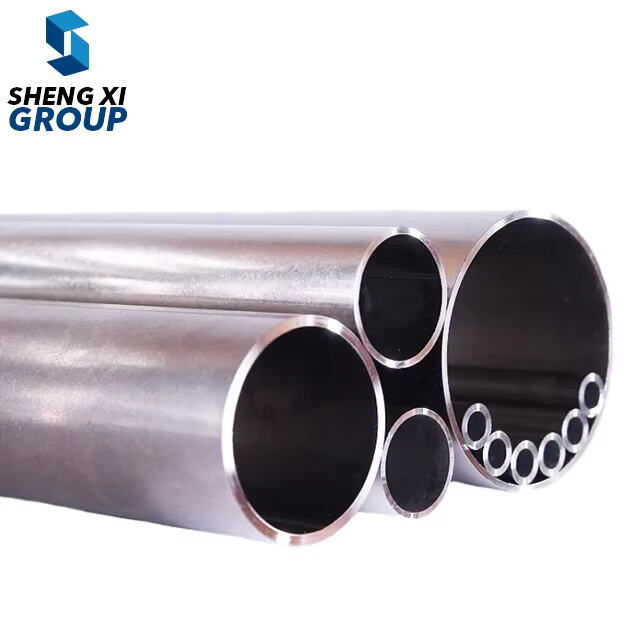Introduction: Why Understanding Steel Types Matters
Knowing about various steel types matters a lot in manufacturing and construction work. Steel serves as a basic building block affecting how long things last and how well they perform across thousands of products and buildings. When someone gets familiar with what makes each type of steel special, better decisions get made regarding project quality and resource usage. This knowledge helps ensure materials match requirements without wasting money on overkill specifications.
Steel really does run through almost everything we do these days. Think about it - cars, buildings, power plants, even the cans that hold our food? All those things rely on steel somehow. But here's something people often forget: there's actually more than one kind of steel out there. Take alloy steel versus carbon steel for instance. They're quite different when it comes down to what they can handle. Some steels are super strong but might rust easily, while others resist corrosion better but aren't as tough under pressure. That's why engineers pick specific types depending on what job needs doing. A bridge needs one kind of steel, kitchen appliances another completely.
In this article, I will delve into a comparative analysis of alloy steel and carbon steel, exploring their unique characteristics and advantages. This understanding will facilitate more strategic decision-making in selecting the right steel type for your specific needs, whether in construction projects or manufacturing applications.
Alloy Steel vs Carbon Steel: Key Differences in Composition
Defining Alloy Steel: Elements and Additives
Alloy steel gets its special properties from extra elements mixed in during production, including chromium, nickel, and molybdenum. These additions aren't just random choices they actually change how the steel behaves in important ways. Take chromium for example it makes the metal stronger while protecting against rust and corrosion, which explains why we see it so much in things like industrial machinery parts that need to last through tough conditions. Nickel gives another boost too, helping the steel handle impacts better without breaking apart. Then there's molybdenum, which basically acts like armor against wearing down over time. Industry data shows that when all these elements work together, alloy steel can resist wear about half again as well as regular carbon steel. That kind of improvement matters a lot in industries where equipment failure isn't an option, especially places like aircraft manufacturing where safety depends on materials holding up under extreme stress.
Carbon Steel Explained: Primary Components
Carbon steel basically consists of iron mixed with carbon, making it one of the simplest types of steel around. What's great about this material is how its basic makeup actually boosts strength while keeping manufacturing relatively simple and cost effective. There are three main types of carbon steel categorized by their carbon content levels. Low carbon steel contains less than 0.3% carbon and remains very soft and workable, which explains why it shows up so much in car parts and pipe manufacturing. When we move to medium carbon steel at 0.3% to 0.6%, we get something that balances toughness with some flexibility, ideal for things like gear systems and drive shafts in machinery. At the top end sits high carbon steel with carbon content ranging from 0.6% up to 2.0%. This stuff gets really hard and strong, hence its popularity among toolmakers for chisels, knives, and other cutting instruments. Because carbon steel doesn't require complicated processing, manufacturers benefit from lower expenses while still getting materials tailored to different job requirements across industries.
Mechanical Properties Showdown
Tensile Strength Comparison
Looking at tensile strength measurements shows that alloy steel typically beats out carbon steel thanks to what's mixed into its makeup. Industry tests have consistently shown this over time, which is why we see alloy steel used so much in things like airplane parts and car engines where materials need to hold up against serious stress without breaking down. When engineers are working on something that needs extra strength, they tend to go with alloy steel since those added elements really do make a difference in how well the material holds together when pulled apart compared to regular carbon steel options available on the market today.
Hardness Characteristics
When looking at how hard different steels are, manufacturers test both alloy and carbon steel using methods like Rockwell and Brinell hardness tests. Alloy steel generally comes out harder because it contains extra elements like nickel and chromium that make it last longer against wear and tear. That's why many factories choose alloy steel for things that need to stand up to heavy use over time, such as gears in industrial machines or drill bits for construction work. Carbon steel remains popular for everyday stuff though since it doesn't have all those added elements, making it easier and cheaper to produce for basic components where extreme durability isn't absolutely necessary.
Flexibility and Impact Resistance
Alloy steel isn't quite the same as carbon steel when it comes to how flexible it is and how well it handles impacts. This difference really matters in actual applications. Alloy steel bends better and takes hits without breaking, so engineers often choose it for things like bridges and tall buildings that need to handle all sorts of movement over time. These traits also matter a lot in manufacturing settings where materials get hit hard but shouldn't deform permanently. When we run tests on these properties, alloy steel generally shows its strength advantages pretty clearly. Carbon steel tends to be stiffer overall, which makes sense why it might not perform as well in situations where things are constantly moving around or getting bumped into.
Corrosion Resistance Capabilities
Alloy Steel's Anti-Corrosion Advantages
Alloy steel stands out because it resists corrosion better than regular steel. This happens mainly when certain metals get mixed into the steel during production. Chromium, nickel, molybdenum these are some common additions that help fight off rust and damage from chemicals. What they do is create this protective oxide coating on top of the metal surface which acts like a shield against the elements. Because of all this protection, we find alloy steel being used a lot in places where normal steel would just fall apart fast. Think about those big chemical factories or ships sailing through salty ocean water day after day. The steel has to hold up against constant attacks from moisture and corrosive substances in those environments.
Carbon Steel's Vulnerability Factors
Carbon steel has its advantages when it comes to cost and widespread usage, but it really struggles against corrosion because there aren't enough alloying elements present to fight off oxidation. The problem gets worse in places where moisture, salt, or chemicals hang around a lot. Think about boats out at sea or factories where chemicals are constantly in the air. These materials just don't stand up well in such environments. Rust forms quickly on carbon steel surfaces, and once that starts happening, the metal begins to break down gradually. Over months and years, this leads to weaker structures and compromised safety in many applications where strength matters most.
Protective Treatments Comparison
Carbon steel needs protection against rust, so folks often apply treatments such as galvanizing or painting. When they galvanize steel, they basically coat it with zinc which acts like armor against rusting. Painting works differently but still creates a barrier between the metal and whatever corrosive stuff might be out there. Both methods help steel last longer before it starts falling apart, which means saving money on repairs and replacements down the road. But there are differences worth noting. Galvanized coatings tend to hold up better outside where weather takes its toll day after day. Indoor spaces usually get painted instead since appearance matters more inside buildings than outside. Some industrial facilities even prefer certain types of paint formulas depending on what chemicals their equipment will encounter regularly.
Practical Applications in Industry
Where Alloy Steel Excels
Alloy steel stands out in industries needing materials that can handle serious stress without breaking down. Take aerospace for instance. When building planes, manufacturers rely heavily on alloy steel for things like landing gear and other structural parts because it just doesn't give way under extreme pressure. The stuff keeps going even when pushed to its limits. Car makers know this too. They use alloy steel throughout vehicles for gears, axles, and inside engines where parts need to last through constant motion and heat. Without those special properties, cars wouldn't stand up to daily driving conditions. Construction companies aren't left behind either. Steel alloys show up everywhere from bridge supports to reinforcing bars in buildings. What makes them so valuable here? Simple. They resist rust better than regular steel and maintain their shape over time, which matters a lot when structures need to stay strong for decades.
Carbon Steel's Primary Uses
People love carbon steel because it doesn't break the bank while still performing really well mechanically, which explains why it shows up so much in construction and manufacturing sectors. When building things, contractors rely heavily on carbon steel for structural parts like beams and columns since it holds up under stress without costing too much money. Manufacturers also prefer this material when making pipes, machine parts, and tools simply because it works great with machining processes and can be welded easily. We see carbon steel everywhere else too - from car parts to bridges and roads across the country. Its ability to provide solid strength at reasonable prices makes it one of those go-to materials whenever budget matters but quality still needs to stay high.
Material Selection Scenarios
Choosing between alloy steel and carbon steel really comes down to what the job actually needs. Projects that require extra strength, need to handle heat well, or must resist corrosion typically call for alloy steel. Take industrial settings where temperatures run hot or there's exposure to chemicals - engineers tend to go with alloy steel because it lasts longer and performs better under those tough conditions. On the flip side, if budget constraints are tight and the application isn't too harsh, carbon steel works just fine for many construction and manufacturing tasks. Most experienced metalworkers have their own mental checklist they run through when making these decisions, weighing factors like environmental conditions, load requirements, and long term maintenance costs before settling on one material over another.
- Assess Environmental Conditions: Determine if the environment is standard or demanding (high heat, moisture, etc.).
- Evaluate Budget Constraints: Consider the project's budget and justify the material expenses.
- Determine Mechanical Requirements: Identify the need for specific mechanical properties like tensile strength or corrosion resistance.
- Make an Informed Choice: Choose alloy steel for demanding conditions requiring enhanced properties and carbon steel for cost-effective solutions.
This structured approach ensures that material selection aligns with both engineering requirements and economic constraints, thereby facilitating effective project management.
FAQ
What are the main differences between alloy steel and carbon steel?
Alloy steel contains additional elements like chromium, nickel, and molybdenum that enhance strength, wear resistance, and corrosion resistance, while carbon steel primarily consists of iron and carbon, offering varying strength and hardness levels based on its carbon content.
Which type of steel is more affordable?
Carbon steel is typically more affordable than alloy steel due to its simpler composition and lower production costs.
In which industries is alloy steel commonly used?
Alloy steel is widely used in aerospace, automotive, and construction industries due to its superior mechanical properties, such as enhanced strength and corrosion resistance.
Why is carbon steel vulnerable to corrosion?
Carbon steel is vulnerable to corrosion because it lacks the alloying elements present in alloy steel that resist oxidative processes, making it susceptible especially in environments with high moisture or chemicals.
How can carbon steel be protected from corrosion?
Carbon steel can be protected through galvanization or painting, which provide barriers against oxidative and corrosive elements.


